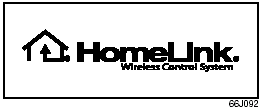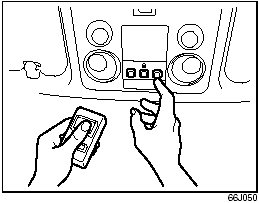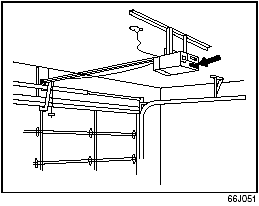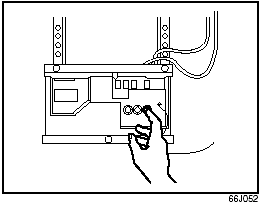 Suzuki Grand Vitara: HomeLinkÂź (if equipped)
Suzuki Grand Vitara: HomeLinkÂź (if equipped)

HomeLinkÂź (if
equipped)
HomeLinkÂź and the HomeLinkÂź house are registered trademarks of Johnson Controls, Inc. The HomeLinkÂź Wireless Control System provides a convenient way to replace up to three hand-held radio-frequency (RF) transmitters used to activate devices such as gate operators, garage door openers, entry door locks, security systems, even home lighting. Additional HomeLinkÂź information can be found on the Internet at www.homelink.com or by calling 1-800- 355-3515. Before programming HomeLinkÂź to a garage door opener or gate operator, make sure that people and objects are out of the way of the device to prevent potential harm or damage. When programming a garage door opener, it is advised to park outside of the garage. Do not use HomeLinkÂź with any garage door opener that lacks safety stop and reverse features as required by U.S. federal safety standards (this includes any garage door opener model manufactured before April 1, 1982). A garage door that cannot detect an object â signaling the door to stop and reverse â does not meet current U.S. federal safety standards. For more information, contact HomeLinkÂź at www.homelink.com or by calling 1-800- 355-3515. Retain the original transmitter of the RF device you are programming for use in other vehicles as well as for future HomeLinkÂź programming. It is also suggested that upon the sale of the vehicle, the programmed HomeLinkÂź buttons be erased for security purposes. Refer to âProgramming HomeLinkÂźâ (step 1) only) or, for assistance, contact HomeLinkÂź at www.homelink.com or by calling 1-800- 355-3515.
Programming HomeLinkÂź
NOTE: Some vehicles may require the ignition switch to be turned to the second (or âaccessoriesâ) position or the âonâ position for programming and/or operation of HomeLinkÂź. It is also recommended that a new battery be placed in the hand-held transmitter of the device being programmed to HomeLinkÂź for quicker training and accurate transmission of the radiofrequency signal. Do not repeat âProgramming HomeLinkÂźâ â step 1) to train additional devices to a second or third HomeLinkÂź button. Begin with âProgramming HomeLinkÂźâ â step 2).

1) Press and hold the two outer HomeLinkÂź buttons (buttons one and three) â releasing only when the indicator light begins to flash (after 20 seconds). Do not hold the buttons for longer than 30 seconds and do not repeat step 1) to program a second and/or third hand-held transmitter to the remaining two HomeLinkÂź buttons. 2) Position the end of your hand-held transmitter 5â14 cm (1â3 inches) away from the HomeLinkÂź button you wish to program while keeping the indicator light in view. 3) Simultaneously press and hold both the chosen HomeLinkÂź and hand-held transmitter buttons. Do not release the buttons until step 4) has been completed.
NOTE: Some gate operators and garage door openers may require you to replace this Programming step 3) with procedures noted in the âGate Operator / Canadian Programmingâ section.
4) After the HomeLinkÂź indicator light changes from a slow to a rapidly blinking light, release both the HomeLinkÂź and hand-held transmitter buttons.
NOTE: If the HomeLinkÂź indicator light does not change to a rapidly blinking light, contact HomeLinkÂź at www.homelink.com or call 1-800-355-3515 for assistance.
5) Press and hold the just-trained HomeLinkÂź button and observe the indicator light. â If the indicator light stays on constantly, programming is complete and your device should activate when the HomeLinkÂź button is pressed and released.
NOTE: To program the remaining two HomeLinkÂź buttons, begin with âProgramming HomeLinkÂźâ â step 2). Do not repeat step 1).
â If the indicator light blinks rapidly for two seconds and then turns to a constant light continue with âProgramming HomeLinkÂźâ steps 6â8 to complete the programming of a rolling code equipped device (most commonly a garage door opener).


6) At the garage door opener receiver (motor-head unit) in the garage, locate the âlearnâ or âsmartâ button. This can usually be found where the hanging antenna wire is attached to the motorhead unit. 7) Firmly press and release the âlearnâ or âsmartâ button. (The name and color of the button may vary by manufacturer.)
NOTE: There are 30 seconds in which to initiate step 8).
8) Return to the vehicle and firmly press, hold for two seconds and release the programmed HomeLinkÂź button. Repeat the âpress/hold/releaseâ sequence a second time, and, depending on the brand of the garage door opener (or other rolling code equipped device), repeat this sequence a third time to complete the programming process. HomeLinkÂź should now activate your rolling code equipped device.
NOTE: To program the remaining two HomeLinkÂź buttons, begin with âProgramming HomeLinkÂźâ â step 2). Do not repeat step 1).
For questions or comments, please contact HomeLinkÂź at www.homelink.com or 1-800-355-3515.
Gate Operator / Canadian Programming
Canadian radio-frequency laws require transmitter signals to âtime-outâ (or quit) after several seconds of transmission â which may not be long enough for HomeLinkÂź to pick up the signal during programming. Similar to this Canadian law, some U.S. gate operators are designed to âtime-outâ in the same manner. If you live in Canada or you are having difficulties programming a gate operator by using the Programming procedures (regardless of where you live), replace âProgramming HomeLinkÂźâ step 3) with the following:
NOTE: If programming a garage door opener or gate operator, it is advised to unplug the device during the âcyclingâ process to prevent possible overheating.
3) Continue to press and hold the HomeLinkÂź button while you press and release â every two seconds (âcycleâ) your hand-held transmitter until the frequency signal has successfully been accepted by HomeLinkÂź. (The indicator light will flash slowly and then rapidly.) Proceed with âProgramming HomeLinkÂźâ step 4) to complete.
Using HomeLinkÂź
To operate, simply press and release the programmed HomeLinkÂź button. Activation will now occur for the trained device (i.e. garage door opener, gate operator, security system, entry door lock, home/office lighting, etc.). For convenience, the handheld transmitter of the device may also be used at any time. In the event that there are still programming difficulties or questions, contact HomeLinkÂź at www.homelink.com or 1-800-355-3515.
Erasing HomeLinkÂź Buttons
To erase programming from the three buttons (individual buttons cannot be erased but can be âreprogrammedâ as outlined below), follow the step noted: Press and hold the two outer HomeLinkÂź buttons until the indicator light begins to flash-after 20 seconds. Release both buttons. Do not hold for longer that 30 seconds. HomeLinkÂź is now in the train (or learning) mode and can be programmed at any time beginning with âProgramming HomeLinkÂźâ â step 2).
Reprogramming a Single HomeLinkÂź Button
To program a device to HomeLinkÂź using a HomeLinkÂź button previously trained, follow these steps: 1) Press and hold the desired HomeLinkÂź button. DO NOT release the button. 2) The indicator light will begin to flash after 20 seconds. Without releasing the HomeLinkÂź button, proceed with âProgramming HomeLinkÂźâ â step 2).
For questions or comments, contact HomeLinkÂź at www.homelink.com or 1- 800-355-3515.
 Roof Rails or Roof Rack Anchors (if equipped)
Roof Rails or Roof Rack Anchors (if equipped)
Roof rails
Roof rack anchors
You can use the roof rails or the roof rack anchors to attach the optional roof
rack which is available at your SUZUKI dealer. If you use a roof rack, observe the
...
See also:
ATA (Anti-Theft Alarm system)
A visual and audible alarm is triggered if the alarm system is armed and you
open:
a door
the vehicle with the mechanical key
the tailgate
the hood
The alarm is not switched off, even i ...
General Information
For service and parts needs, visit your dealer. You will receive genuine GM parts
and GM-trained and supported service people. Genuine GM parts have one of these
marks:
...
Lights
Have someone observe the operation of exterior lights
while you work the controls. Check turn signal and high
beam indicator lights on the instrument panel. ...

